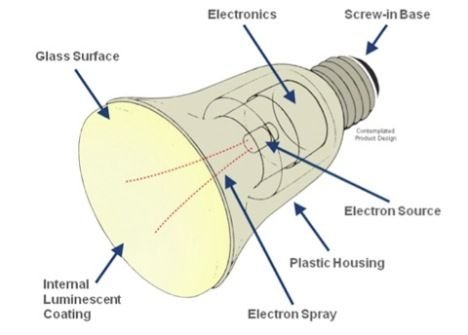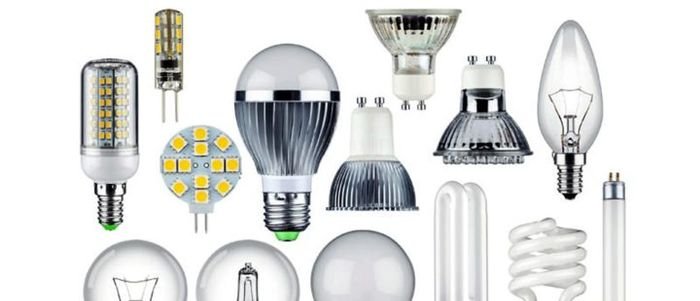This is the second part of operation and parameters of lamps. Are shown luminescent lamps: fluorescent, ESL and LEDs.
The first part is in link below:
Luminescent lamps
Fluorescents

Inside the fluorescent lamps there is a low pressure inert gas, usually argon, and a small quantity of mercury. Each side of lamp has electrodes and a filament made of tungsten coated with oxide. Tube’s internal walls are coated with phosphorus.

When the lamp is on in alternate current, mercury is evaporated. Filaments are heated, a potential difference is created between then, one serves as cathode and other side as anode. Electrons are emitted and enter in contact with argon (Ar) and mercury. Therefore, the inert gas becomes ionized.
e^{-}+Ar\rightarrow Ar^{+}+2e^{-}
How light is produced? When electron comes in contact with the atom, the latter gains energy and stay in a state of higher energy. However, this state is unstable and when atom’s electron goes to a lower energy layer it emits light.

The light of mercury atoms is ultraviolet, when this light is in contact with phosphorus, it becomes visible and white.

Fluorescent lamps are more efficient than incandescent ones, because the former emit much less heat. Have between 5000 and 10,000 hours of lifespan, the compact fluorescent lasts in average 8000 hours. Have energetic efficiency between 60 and 70%, luminous efficiency between 50 and 100 lumens/watt and IRC of 85. Exist cold cathode lamps which will be subject to another post.
ESL

The electron stimulated luminescence (ESL) or cathodoluminescence is an alternative to compact fluorescents and LEDs. Electrons from a metallic plate, the cathode, are accelerated by an electric field in direction to a phosphorus coated layer. When electrons hit the phosphorus layer, light is emitted. This technology is similar to cathode rays tube of old television.

This type does not have heavy metals and don`t get heated. Lasts 10,000 hours, luminous efficiency between 30 and 45 lumens/watt and IRC between 85 and 90. This lamp is 70% more efficient than standard incandescent. The main disadvantage is the weight.
LEDs

Have been written a post about operation of LEDs.
A LED lamp have many high brightness LEDs controlled by an electronic circuit. Can be necessary a heat sink due to electronic part. Are harder to break than other lamps for being solid state.

This is a typical LED control electronic circuit for illumination.

Already exist lamps which produce hot colors. The phosphorus (04) was modified to produce a hot color similar to an incandescent lamp.

In the post about light pollution, I suggested the creation of LED lamps which reproduce hot colors because cold colors can affect living beings in a negative way.
Exist lamps in other forms beyond bulb.

Can have until 50,000 hours of duration. Luminous efficiency can go from 40 to 100 lumens/watt, some can reach 200 lumens/watt. While IRC is between 60 and 80. LED lamps have the highest energetic efficiency of all, are 95% more efficient than standard incandescent.



